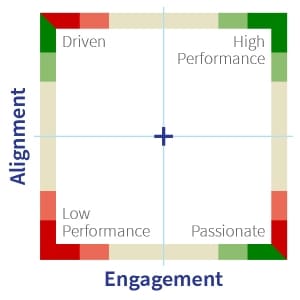The importance of customer surveys
We all know the importance of satisfying customers, but few businesses actually check whether they're doing just that. There's no way to know for certain unless they ask.
Benchmarking board performance: 500 board reviews later
Unlock evidence-based insights into board performanceInsync’s Alignment and Engagement Survey is built on academic research that shows the two greatest drivers of organisational performance are alignment and employee engagement.
Over the past year we’ve worked with a public sector organisation to help it achieve a very significant increase in alignment and employee engagement. This puts them well on the path towards becoming a high performance organisation.
The Alignment and Engagement framework (below) shows where the organisation is positioned relative to Insync’s benchmark database. In November 2011 its alignment was in the bottom quartile of the database, with its employee engagement score at the lower end of the second quartile.
By July 2012, it had improved both alignment and engagement, taking it to the midpoint of our benchmark database.


The increases in alignment and engagement have resulted in a substantial improvement in key HR metrics, with staff turnover reducing from 19% to 11.5% and absenteeism reducing from 4.5% to 2.8% resulting in very significant financial savings.
In 2011, the organisation recognised that its culture was not conducive to achieving success. It decided to implement a transformation program with four key areas of focus: leadership development, guidance and positioning statements, team effectiveness and HR practices.
The organisation took great care to understand the leadership attributes required to take the organisation through the next three to five years. They either assisted existing leaders to improve their capabilities or brought in new executives and senior managers to drive the organisation forward. These changes are reflected in both the senior leadership and team leadership factors of the survey. Now 70% of employees agree that team leaders, managers and executives within the organisation support the organisation’s chosen long term aims (up 10% from July 2011).
The organisation engaged the extended leadership team of 25 people in a full day workshop to refresh their core purpose and aspiration for communication with staff and clients. Employees are clearer about the organisation’s long term direction (improved by 11%) and are receiving better support and tools to enable execution of the strategy, evidenced by this employee comment: “There is a real commitment to empowerment and to providing clarity of direction to our people and to stripping away inefficient or useless practices”.
They invested significantly in fostering a positive work environment, and in team building initiatives to ensure that people work together and treat each other with respect and consideration. This improvement was reflected in the survey with 61% of employees agreeing that the chosen values and behaviours are demonstrated every day in their team (up 14%). It also updated its workplace behaviours policies and procedures for managers and staff. It was also supported by training in negotiation skills to deal with conflict mediation and resolution. The goal of this was to deal with issues early in a one-on-one discussion and avoid escalation through the formal processes, which can reduce the likelihood of an amicable resolution.
Recruitment practices were improved to ensure that only people with the right skills and cultural fit are brought into the organisation. The on-boarding process for new employees has also been considerably strengthened. It ensures new employees are engaged socially with the support of a “buddy”, and are clear on their performance and progression throughout a 90 day on-boarding program that is run in conjunction with their manager and HR. Performance management practices have been improved by ensuring that employees receive constructive feedback on performance, and guidance on how to utilise areas of strength and deal with areas requiring improvement.
The substantial improvement that has been achieved in eight months demonstrates that focused and deliberate interventions, with the right measurement, can have a substantial impact on alignment and engagement in a relatively short period of time. The majority of employees are now emotionally invested in the organisation, think positive things about it and are prepared to apply discretionary effort to lift its performance.
“There is a much more positive ‘vibe in the air’. The behaviours of most executives and senior managers have improved. There is a much stronger sense of respect and integrity, transparency and collegiality within the organisation.”
We all know the importance of satisfying customers, but few businesses actually check whether they're doing just that. There's no way to know for certain unless they ask.
Many organisations across Australia and the world are learning how discovering and living a new and higher order purpose can transform their organisation from the ...
Ground-breaking research into the 5 key people drivers of the profitable growth cycle based on our experience from conducting over 1000 employee and customer surveys ...
One of the easiest & most effective ways to ensure good performance is to ensure gender-balanced workgroups.
We use cookies to enhance your experience. Further use is considered consent. You can read more about cookies in our Privacy Policy.


You’ll always get a real person when you contact Insync.
Let's get started